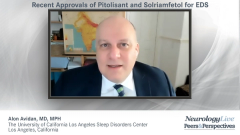
The Impact of COVID-19 on the Management of Narcolepsy
Key opinion leaders consider the impact of the COVID-19 pandemic on the diagnosis and treatment of narcolepsy and comment on improvements in symptom management at home.
Episodes in this series

Phyllis Zee, MD, PhD: It is difficult during this time of COVID-19 [coronavirus disease 2019] not to talk about the challenges of even diagnosing or treating patients with narcolepsy, following them up, and developing goals for remote telemedicine. We have been following most of our patients by telemedicine, which has been OK. The big challenge for me is how exactly I monitor their blood pressure. How do I look at some of their vital signs? Some of my patients buy blood pressure monitors, so they already know. They put it into my chart, but it is not ideal. It is certainly something that has allowed our patients to be self-monitoring a bit more, especially when they are on some of these medications that we may have some concerns about.
Diagnosis is a little tougher because how do we do that MSLT [multiple sleep latency test] or that polysomnography? We are now open, so we are able to do that most of the time. What has been your experience with treating and diagnosing patients during COVID-19?
Alon Avidan, MD, MPH: It has been fascinating, Dr Zee. Similarly, we have done all our visits by telemedicine. What I can tell is that the volume of patients has probably doubled because everyone is able to show up. Here in Los Angeles, taking the freeway to see your doctor is a half-a-day ordeal thanks to taking time away from work and commuting. Telemedicine has actually made access a lot better. It has provided us the ability of seeing the patients who live 3 hours away and need to have their CPAP [continuous positive pressure therapy] for sleep apnea evaluated for compliance monitoring a lot easier. The rate-limiting stuff, of course, is technology and the internet, but people are getting used to it. For older patients, their grandchildren are critically important in getting the video visits set up. We always tell the patients to look to their neighbors, friends, and grandchildren, and it works pretty well.
Initially, when the pandemic struck last March, we saw a fairly large rise in patients coming in for insomnia. These are patients who have had problems with insomnia even before, but it seems like the pandemic has exacerbated and perpetuated it, as well as the worrying at night and participating in behaviors that you and I would never approve of, like watching TV and using electronics at bedtime. Interestingly, patients with previously diagnosed daytime sleepiness have gotten a bit better, and we recognize that it may be because they do not have to be at work at a particular time. What we have found is that they go to bed late and wake up late. You may have seen the same. It was almost a delayed pattern.
Phyllis Zee, MD, PhD: Patients also do not have to commute. In many ways, they are decreasing that, and some of my patients with narcolepsy can now take naps between their Zoom meetings. They are taking a nap here and there, which is much easier because they are in their own homes rather than at work where there may not be any opportunity to take naps. It looks as if we have come a long way in both diagnostic tools as well as therapeutic approaches. We clearly still need a lot more with regard to efficacy. We talked about safety being something that continually needs to be developed, especially pharmacological therapies. Even cognitive behavior therapy for narcolepsy is being developed right now by some of our behavior sleep medicine folks, and that would be an important aspect in the future.
Alon Avidan, MD, MPH: To your point, from a vaccination point of view, I want to go back to the issue of the H1N1 vaccination campaign, which resulted in a rise in folks with narcolepsy in Scandinavia. I do not know if you have seen anything, Dr Zee, in type 1 narcolepsy in relationship to the Moderna and Pfizer coronavirus vaccines, but it is probably a good thing to keep our eyes on to see what the rates end up looking like.
Phyllis Zee, MD, PhD: The data are probably stronger regarding the vaccine and the adjuvant setting, and it is probably stronger with the infection itself. We have not seen that in the reports at least, other than insomnia being more common in these patients. On the other hand, a patient with preexisting autoimmune disorders may already be at increased risk to begin with.
Thank you for watching this NeurologyLive® Peers & Perspectives® program. Please subscribe to the e-newsletter to receive upcoming Peer Exchanges® and other great content in your in-box.
Transcript Edited for Clarity
Newsletter
Keep your finger on the pulse of neurology—subscribe to NeurologyLive for expert interviews, new data, and breakthrough treatment updates.




























